Today we have a bit of a different piece. We are going to take a look at Lenovo’s crown jewel workstation… again. We reviewed the Lenovo ThinkStation P620 when the Threadripper Pro 3995WX was king. Now we have the newest WEPYC (workstation EPYC) from AMD in the AMD Ryzen Threadripper Pro 5995WX, and we have an updated Lenovo system to boot. As such, we did something a little bit different this time: we have competition.
The Lenovo ThinkStation P620 v. Supermicro AS-5014A-TT Video
Since this is largely the same platform as we reviewed last time, instead of re-hashing all of the same details, we decided to take a look at another offering the market, specifically a system from Supermicro. You can find the direct comparison video here:
We also have reviewed the ASUS Pro WS WRX80E-SAGE SE WIFI and Gigabyte MC62-G40 motherboards, but we are making a direct comparison against Supermicro since we had these two fully configured systems. For those wondering why the Supermicro one is not coming out first, we are rushing behind the scenes due to a number of deadlines, but if you want to learn more about the Supermicro system, see the above video.
With that, let us get to areas of comparison.
Lenovo ThinkStation P620 Overview
If you want to see our full review, again, see the Lenovo ThinkStation P620 review.
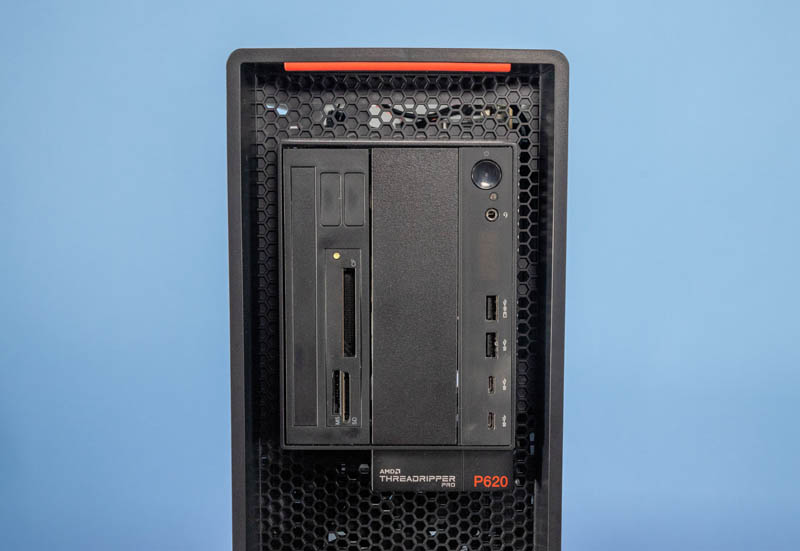
On the front of the system, Lenovo still has the card reader we saw on the first unit and four USB ports. Expansion is via a 5.25″ bay and a slim optical drive reader. Supermicro has one fewer USB Type-C port but two extra Type-A ports and more audio jacks. The 5.25″ bays on the Supermicro are hidden behind the door instead of being directly exposed.
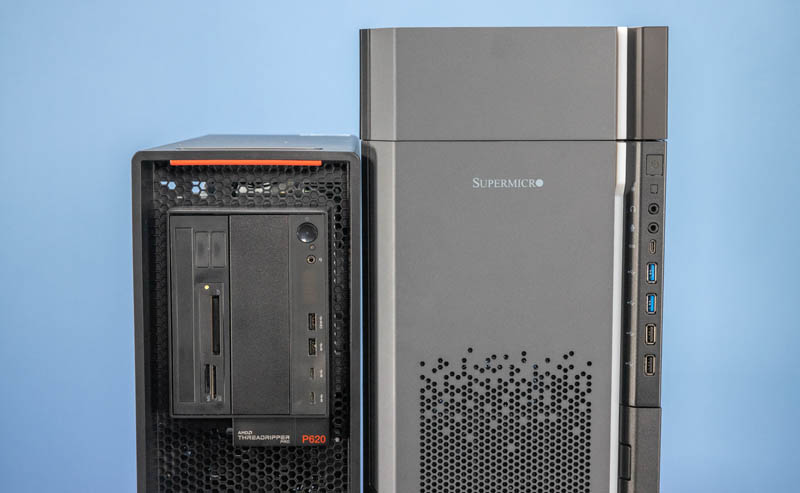
Supermicro also has two 2.5″ SATA bays on the front of the system. To fit everything, these two workstations take very different approaches. Lenovo is focused on providing a compact platform, while Supermicro is notably larger.
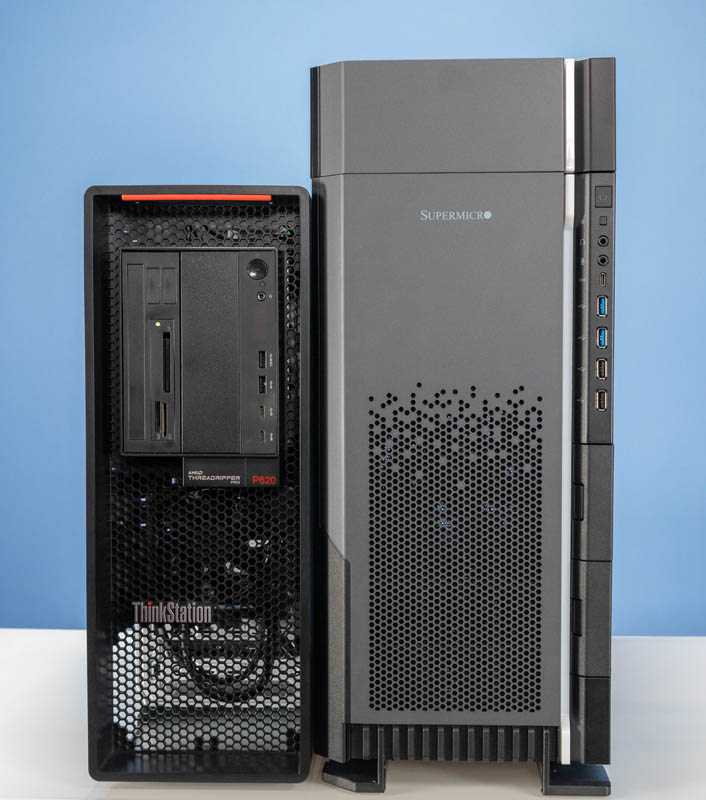
On the rear, we get the same audio, USB, PS/2, and networking configuration we saw in our previous review.
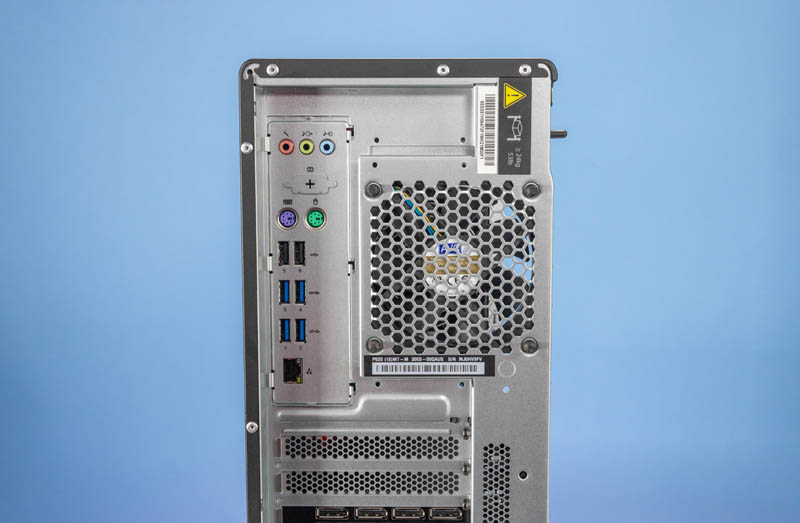
Lenovo uses AMD DASH for management, while Supermicro has its full server IPMI solution. Supermicro seems to be placing its second Type-C port on the rear of the unit along with seven USB Type-A ports. Lenovo has six. Supermicro also has a 7.1 audio solution with optical output alongside five audio jacks. Lenovo has only three and foregoes the S/PDIF optical output.
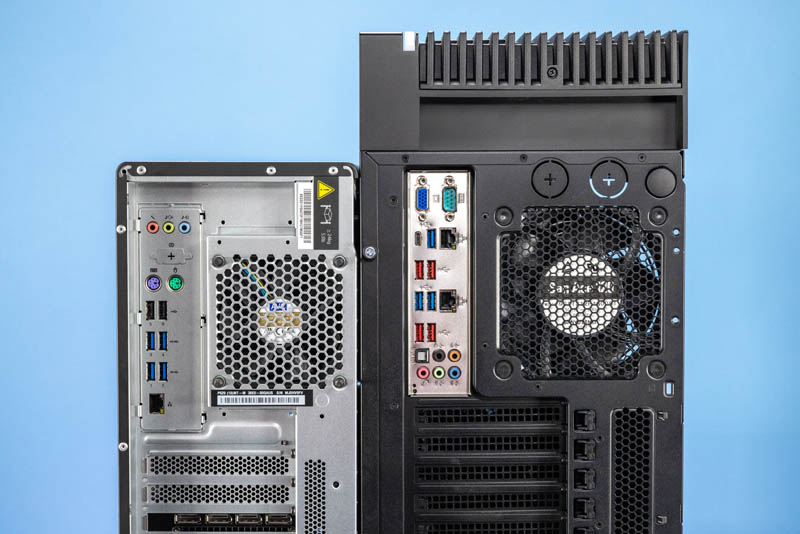
Lenovo removes one extra I/O rear slot. Neither motherboard has seven slots, so Lenovo has a more compact package.
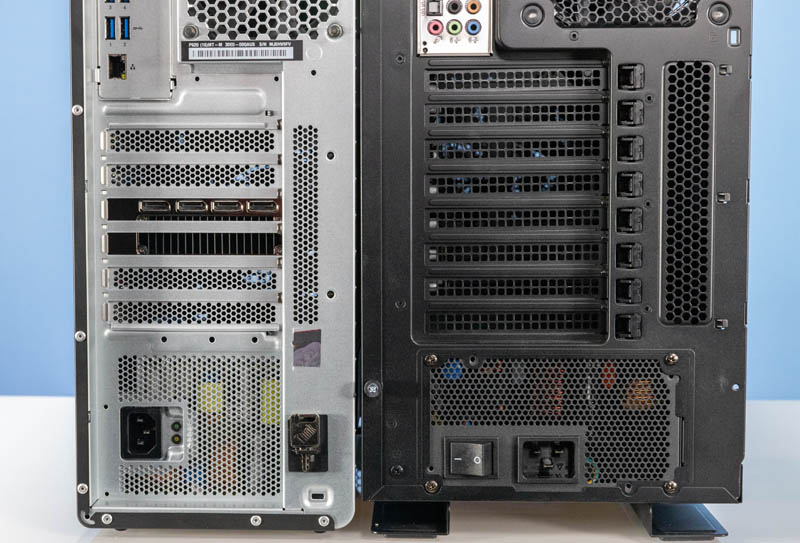
Lenovo has a great 1kW PSU that is easy to remove in a tool-less fashion like a server power supply. Supermicro has a 1.2kW-2kW PSU, but it is cabled.
Next, let us get inside the systems.
Lenovo ThinkStation P620 Overview
Lenovo’s handle to get inside the P620 is still excellent and is easier to access than Supermicro’s thumb screw plus button clear cover.
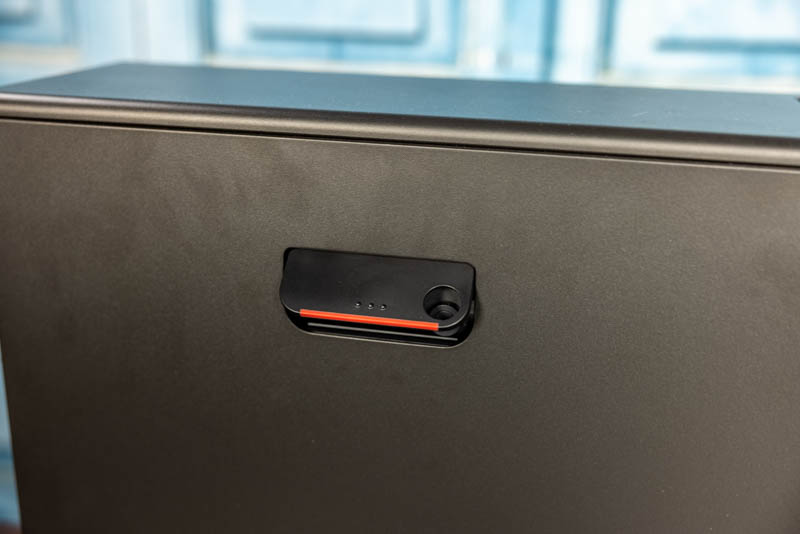
Inside the Lenovo P620, we can see that Lenovo prioritizes direct access to components, while Supermicro has an airflow guide to help fill the larger chassis.
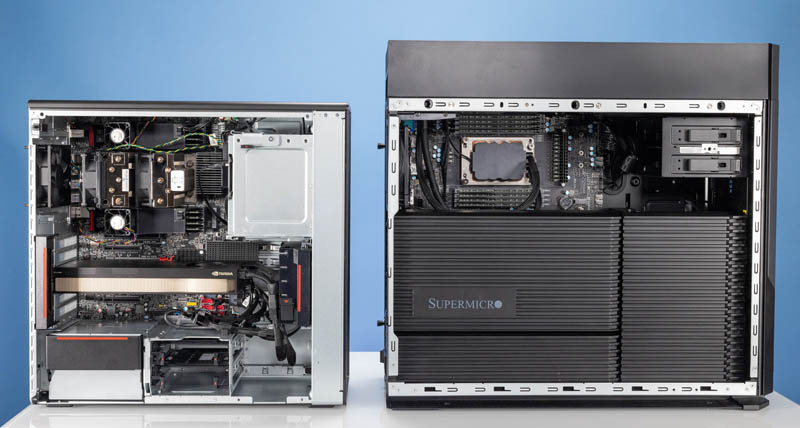
Overall, Lenovo has great serviceability with features like red coloring for handling points during servicing. Lenovo has an easier retention mechanism for GPUs on both ends.
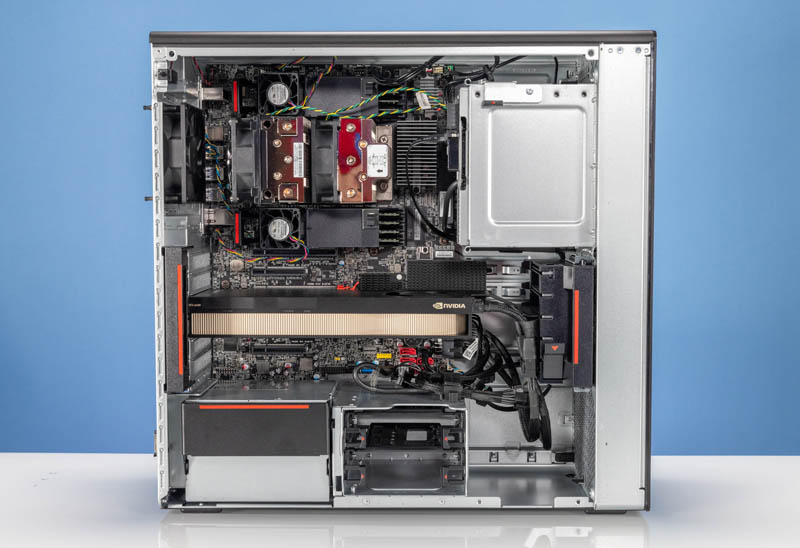
A unique Lenovo feature is the coolers over memory. Lenovo does not have a lot of airflow over this part of the chassis, so these coolers are needed. Lenovo also is using air cooling here instead of liquid cooling.
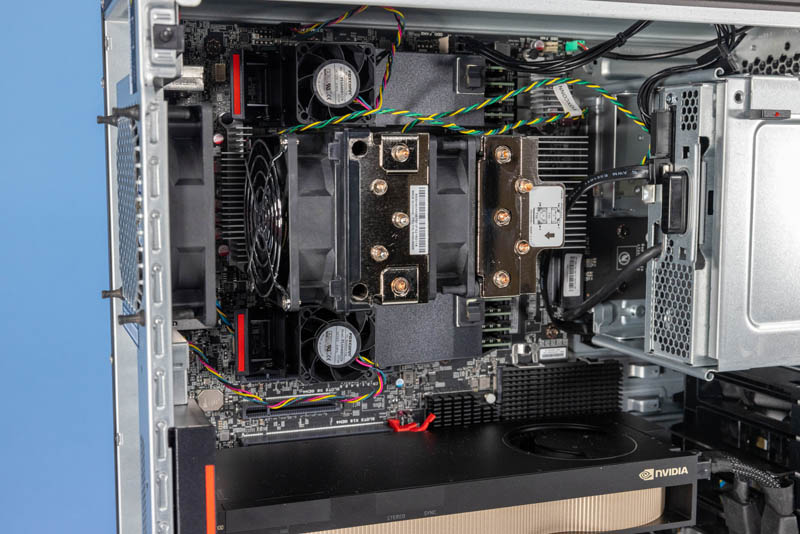
Lenovo has six PCIe Gen4 x16 expansion slots, four x16, and two x8.
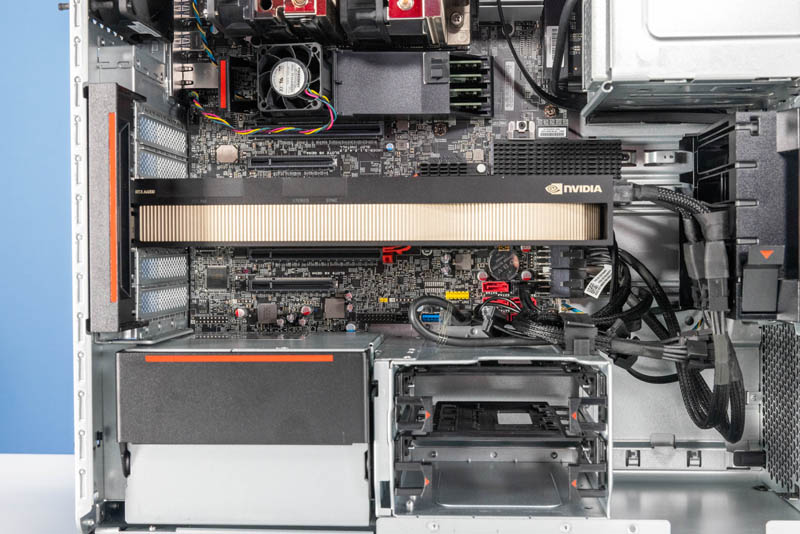
Storage for Lenovo comes in the form of two 3.5″ bays (shown above) with two more optional. Lenovo has six SATA III ports and two M.2 SSD areas shown under the heatsink below.
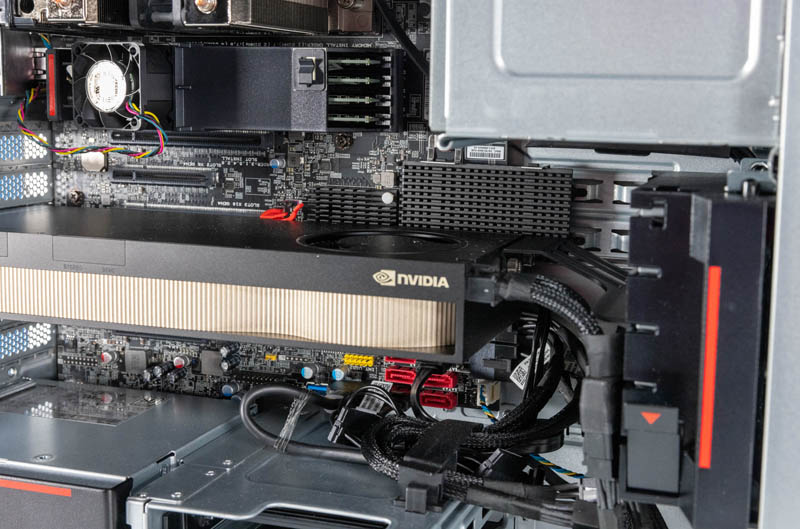
While many of these systems just have a GPU, many studios are now embracing large internal local cache storage, with cards like the HighPoint SSD7540 8x M.2 NVMe SSD Card Review being added after.
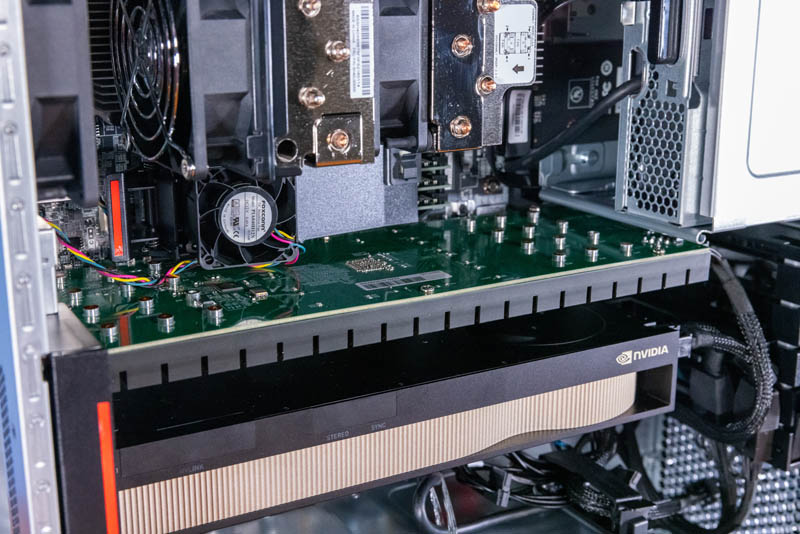
Supermicro has more expansion PCIe lanes (six x16), more M.2 storage slots (4x M.2), and more U.2 (2x U.2), but two fewer SATA ports. The memory capacity and processors can be the same, but Lenovo has to trade off some expandability for space.
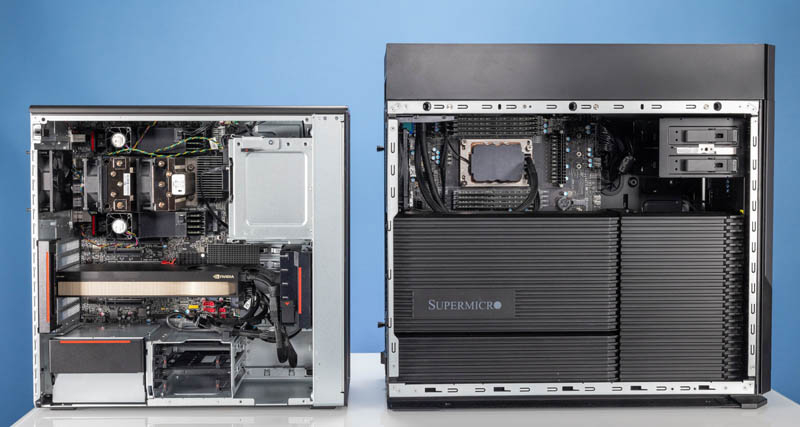
The biggest difference, aside from the space, and the expansion, comes down to cooling. Lenovo is air-cooled while Supermicro is liquid-cooled. We want to know whether that impacts performance, so that is what we are going to explore next in our performance section.

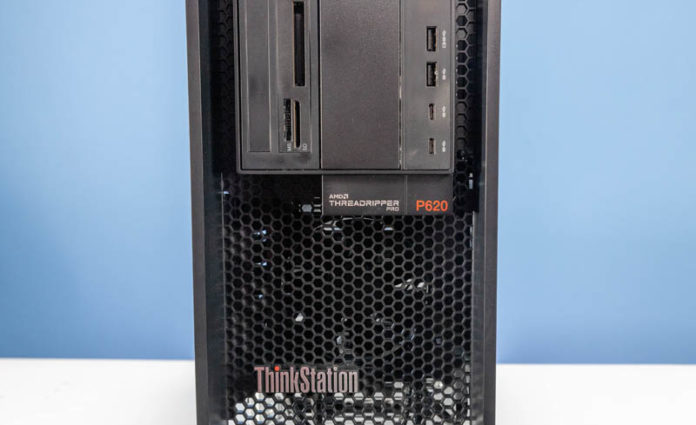



the supermicro looks nice
thanks STH for mentioning that lenovo locks its CPUs to their motherboards, shame on this practice.
re P620, i cannot fathom paying premium for Threadripper CPU and not getting full access to all available PCI lanes, and this poor selection of USB ports and even no front-panel available 2.5″ slots, not to mention no hot-swappable nvme.
What about Noise, DPC latencies?
can’t turn off PSB in Lenovo-bios?
@altmind. Wasn’t there something about deciding whether to vendor lock the CPU at first boot? Of course, I do not condone this practice, but maybe it’s not as bad as it is portrayed to be, since it would rather depend on the customers’ IT departments. (insert potential jokes here)
You had till you said vendor locked CPUs. Now I want nothing to do with any Lenovo.
Thanks Patrick. TR is a nifty CPU, lots of PCIe. But AMD has made it so expensive and so hard to find, it is in it’s way more esoteric than much of the other stuff you cover here.
Actually the CPU vendor lock was an AMD idea. People were arbitraging Threadrippers off Lenovo workstations in the used market and putting bottom of the barrel TR’s in the Lenovo chassis and then dumping them. Lenovo, to no blame of themselves, didn’t want to be in the Threadripper CPU supply business.
Please see the recent thread in Lenovo’s general discussion forum about the engineering failures of the second gen P620. Your conclusions will be dramatically altered in favor of the supermicro system once you learn about the RAM limitations, frequent QC lapses like deafening coil whine in many units with the 5XXX processor, the poor consumer grade customer service, and many other problems. It’s valuable perspective that highlights just how fragile the second-gen P620 really is for upgradability (more RAM, Linux systems, etc) and professional work. I don’t think it’s fair to say anyone would be happy with such a shoddy piece of untested engineering (virtually untested for the 5xxx) restricted to only the tiny drives, ram, and windows OS (Linux systems suffer from the C6 sleep bug after highly threaded loads terminate and the system returns to idle).
Please consider revising this review in light of the struggles and admissions by Lenovo employees (confirming lack of support for over 512gb ram on the 5XXX series, lack of support for full size hard drives due to airflow constraints, etc).
P620 is a total trainwreck off a system, keeps rebooting randomly, gives a s202 error, sometimes 2 times a day, apperently nobody knows how to fix it.
Do not buy it, go for a Dell system.
Specs might be good, put if the sytem keeps crashing then what is the use of those specifications.